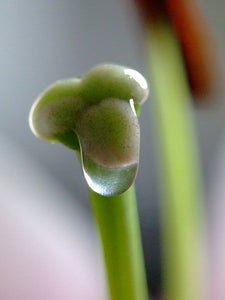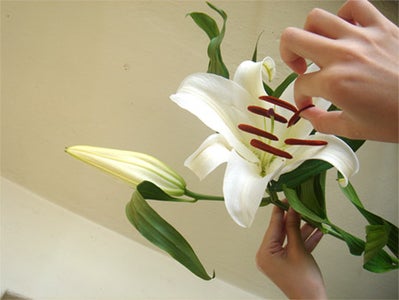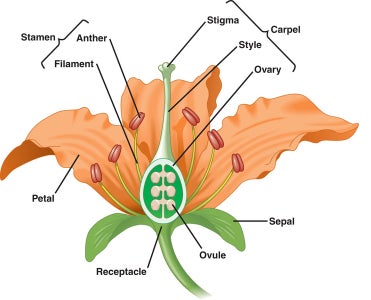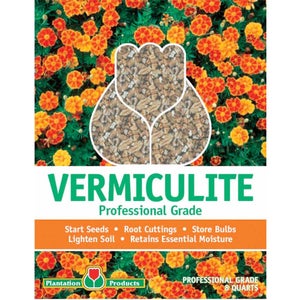Lilies are beloved for their elegant, trumpet-shaped blooms and sweet fragrance. While they make stunning cut flowers, did you know you can also collect seeds from the spent stems to grow new plants? It’s a simple, rewarding way to propagate your favorite lily varieties right from a floral bouquet.
In this article we’ll explore when and how to harvest lily seeds from cut stems. We’ll also cover how to plant and grow the seeds into bulbs that will burst into bloom within 2-3 years. Follow these tips and those fading flowers can yield a bountiful harvest for your garden.
An Overview of Collecting Lily Seeds from Cut Stems
Many cut flowers like lilies continue their life cycles even after being cut and placed in vases. As the blooms fade and shrivel away, seed pods will start swelling at the base of the flower as the seeds inside mature. Before the pods split open and scatter the seeds, you have a prime opportunity to collect them.
Here’s a quick rundown of the process
-
Monitor faded blooms for the formation of green, rounded seed pods.
-
Allow pods to ripen until they turn yellowish brown and develop a bumpy, cracked appearance.
-
Carefully remove ripe pods and split them open to extract the flat, winged seeds within.
-
Save seeds to plant right away or store in a cool, dry place.
-
Sow seeds in starter trays and provide warm, moist conditions for germination.
With proper harvesting and care, those rescued lily seeds can grow into flowering size bulbs within 2-3 years. It’s a simple way to propagate your favorites!
Step-by-Step Guide to Harvesting Lily Seeds from Cut Stems
Follow these steps for successfully gathering lily seeds from the spent stems of cut flowers:
Choose the Right Lily Variety
Ensure the lilies you select readily produce viable seeds. Trumpet, oriental, and LA hybrid lily types are all excellent seed producers. Avoid sterile varieties or those genetically modified not to set seed.
Identify Mature Seed Pods
After cut lily blooms are spent, leave stems in water another 2-4 weeks. Watch below the faded flowers for green, plump seed pods to form and gradually enlarge.
Monitor for Ripe Pods
Check pods daily as they mature. Ripe lily seed pods will turn yellowish or brown and develop a bumpy, cracked appearance when ready for harvest. Pick immediately before pods split open.
Remove Pods Gently
Use pruners or scissors to carefully snip off mature pods. Avoid crushing them. Gently place harvested pods into labeled paper envelopes or bags.
Split Pods and Extract Seeds
Working over a sheet of white paper, gently pry pods open with your fingers to release the seeds. Flat, winged seeds will spill out. Gently scrape any remnants from pods.
Dry and Store Lily Seeds
Spread extracted seeds onto paper and allow to fully dry for about one week. Place dried seeds into envelopes or jars labeled with the variety and date. Refrigerate until planting.
With close monitoring and careful harvesting, cut lily stems can provide an abundant seed harvest!
Optimal Conditions for Growing Lily Seeds
Lily seeds need very specific conditions to successfully sprout and grow into bulbs. Here are their key preferences:
-
Soil: Rich, humus-heavy potting mix with excellent drainage. Maintain mild acidity around 6.0-6.5 pH.
-
Light: Bright, filtered sunlight is essential. Avoid intense direct sun.
-
Water: Keep soil consistently moist but not saturated. Allow pots to partially dry out between waterings.
-
Temperature: Ideal temperatures for germination are 60-70°F (15-21°C). Maintain warmth after sprouting for vigorous growth.
-
Fertilizer: Use only half strength balanced fertilizer until seedlings establish. Then increase to full strength.
Meeting these optimal requirements will ensure your harvested lily seeds grow into healthy bulbs.
Step-by-Step Guide to Growing Lilies from Seeds
Follow these steps to successfully plant and raise lilies from harvested seeds:
Sow Seeds in Trays
Fill starter trays with moist, well-draining seed starting mix. Sow 2-3 seeds per cell, 1⁄4 inch deep. Gently water after planting without washing out seeds.
Provide Bottom Heat
Place trays on heating mats or pads set to 65-70°F (18-21°C). Bottom warmth is vital for robust germination. Cover trays with plastic domes to retain moisture.
Germinate in Low Light
Keep seeds in low light as they germinate over 14-30 days. Move to brighter filtered light after sprouting to prevent leggy growth. Frequently rotate trays.
Thin Seedlings
Clip off weaker seedlings with scissors once 2 sets of true leaves emerge. Leave only the strongest seedling per cell to grow on. Handle emerging plants very gently.
Transplant into Pots
Carefully transfer seedlings into 3-4 inch pots filled with rich potting mix once they outgrow cells. Bury stems just below soil level. Space plants adequately.
Grow On Cool & Bright
Move pots to a cool, bright spot around 60°F (15°C) to simulate winter dormancy. Allow 1-2 years for small bulbs to form and generate foliage. Cease watering once leaves die back.
Transplant Bulbs Outdoors
After 2 years of growth into bulbs, transplant dormant bulbs into garden beds in fall. Choose partial shade sites and mulch well for cold protection.
With close care and perfect conditions, rescued lily seeds will reward you with elegant blooms in just a couple years!
Troubleshooting Common Problems
Even when carefully following protocols, issues can pop up when growing lily seeds. Watch for these potential problems:
-
Seeds fail to sprout: Ensure seeds are fresh and soil is sufficiently warm. Scarify extremely hard outer seed coatings before planting.
-
Leggy, weak growth: Provide more sunlight immediately after germination. Frequently rotate trays to prevent seedlings leaning toward light.
-
Yellowing leaves: Usually signals overwatering. Allow soil to dry out more between waterings. Improve drainage if needed.
-
Bulbs don’t form: Seedlings grown too warm or without winter dormancy period will only form foliage, not bulbs. Move to a cool spot for bulb development.
-
Bulbs rot in pots: Drainage issue from excessive moisture retention. Repot in very porous mix. Allow soil to moderately dry between waterings.
With attentive care and troubleshooting, gardeners can overcome challenges and successfully grow lily seeds into flowering bulbs.
Harvesting Seeds from Other Popular Cut Flowers
Many cut flowers produce abundant seeds that can be gathered and grown into new plants. Follow these tips:
-
Sunflowers: Allow cut blooms to completely fade and dry on stalks before harvesting seed heads. Air dry heads in bags. Rub to remove seeds.
-
Marigolds: Pick dried flower heads when petals detach naturally. Rub heads over a bowl to extract seeds, then spread on towels to fully dry.
-
Zinnias: Harvest dried flower heads when petals easily detach. Gently rub to remove seeds. Further dry on trays or in bags.
-
Dahlias: Allow tubers to re-sprout in spring after flowering ends. Detach and dry the small tubers on old stems. Replant tubers.
-
Lavender: Monitor faded flower heads until completely dry on plants. Clip into bags. Firmly rub heads over a bowl to extract tiny seeds, then fully dry seeds.
Many blooms can yield abundant seeds for propagation if harvested at the right stage using proper techniques. Get propagating!
Enjoying the Rewards of Growing Lilies from Seeds
Raising lilies from the seeds of cut flowers takes dedication over multiple years. But the payoff is years of enjoyment as those delicate seeds flourish into elegant, fragrant blooms.
There’s immense satisfaction in nurturing seeds into bulbs and ultimately gorgeous flowers. You’ll gain skills to grow plants from start to finish.
Each lily that bursts into bloom will serve as a reminder of the beauty hidden within a faded blossom. A simple floral gift can become a legacy flowering for years in your garden when its seeds are rescued and grown.
So before discarding spent lily stems, take a moment to check for plump seed pods. You never know what abundant new life and beauty may be waiting within!

Step 2: Decide Who’s Who Decide which flower is going to be the mommy and which is the daddy. You will use the pollen from the anthers on the daddy to pollenate the stigma of the mommy. Hopefully it will catch and you will grow a seed pod!



Introduction: How to Germinate Lilies



Grow These Top Perennial Cut Flowers!! Ball Seed Customer Days Education Series
FAQ
Can you get seeds from lily flowers?
- Wait for the pods to dry: After the flower fades, the seed pods will form at the end of the bloom stem. Look for them to turn brown and dry out, and for the top to start splitting open.
-
YouTube · Gardening Dreamhttps://www.youtube.comWhat Are Seeds In Lily Bloom And How To Harvest Them? – YouTubeNov 24, 2021 — how to collect lily seeds lily seeds should be gathered in late summer or autumn. this is after the pods have completely dried out and begun dis spl…
-
- Collect the pods: Once the pods are dry and ready to split open, you can harvest them.
- Open the pods: Break or gently split open the dried pods to reveal the seeds inside.
- Remove the seeds: Carefully remove the seeds from the pod, ensuring you don’t lose any.
- Store or plant: You can either plant the seeds right away or store them in a cool, dry place for later use. The Flower Shop Network suggests storing seeds in a resealable bag in the refrigerator’s vegetable crisper.
Can you collect seeds from cut flowers?
- For many flowers, you’ll need to let them fully mature into seed heads. This means waiting for the flower to convert into a seed pod or a dry seed head.
- Some flowers, like zinnias and calendulas, have seeds attached to the base of the dry petals.
How do you germinate lily seeds?
- Timing: Sow seeds in late winter or early spring in a cold frame, or sow seeds in late fall or early winter in a cold frame, depending on the species.
- Soil: Use a fertile, well-draining soil mix.
- Depth: Sow seeds slightly below the soil surface, about one inch deep.
- Water: Water thoroughly after planting and keep the soil consistently moist.
- Germination Time: Germination can take anywhere from a few days to several weeks, depending on the lily species.
- Light: Some lilies need light for germination, while others prefer shade.
Do lilies self-seed?
-
Self-pollination:Lilies can self-pollinate, meaning they can fertilize themselves without needing cross-pollination from another lily.
-
Seed production:After pollination, the lily will develop a seed pod that will eventually dry out and release seeds.
-
Self-seeding:If the seeds are not removed, they can fall to the ground and germinate, leading to new lily plants.
-
Hybrids and seed quality:Some hybrid lilies may produce seeds that are not viable or may not produce true-to-type offspring.
-
Seed germination:Lily seeds have different germination requirements. Some are easy to germinate, while others require specific temperature or light conditions.
